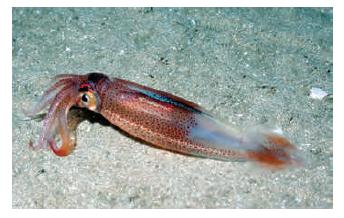The giant axon of the squid (Figure Q113) occupies a unique position in the history of our
Question:
The giant axon of the squid (Figure Q11–3) occupies a unique position in the history of our understanding of cell membrane potentials and nerve action. When an electrode is stuck into an intact giant axon, the membrane potential registers –70 mV. When the axon, suspended in a bath of seawater, is stimulated to conduct a nerve impulse, the membrane potential changes transiently from –70 mV to +40 mV.
Figure Q11-3

For univalent ions and at 20°C (293 K), the Nernst equation reduces to
V = 58 mV × log (Co/Ci)
where Co and Ci are the concentrations outside and inside, respectively.
Using this equation, calculate the potential across the resting membrane (1) assuming that it is due solely to K+ and (2) assuming that it is due solely to Na+. (The Na+ and K+ concentrations in the axon cytosol and in seawater are given in Table Q11–1.) Which calculation is closer to the measured resting potential? Which calculation is closer to the measured action potential? Explain why these assumptions approximate the measured resting and action potentials.
Table Q11-1

Step by Step Answer:

Molecular Biology Of The Cell
ISBN: 9780815344322
6th Edition
Authors: Bruce Alberts, Alexander D. Johnson, Julian Lewis, David Morgan, Martin Raff, Keith Roberts, Peter Walter




